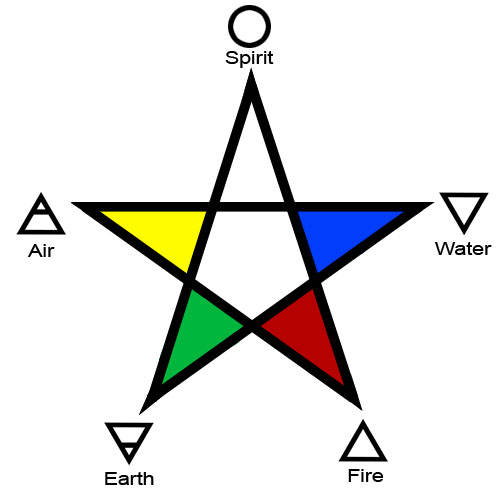
Fire, Water, Earth--with the Fifth Element, Spirit, at
the top. Spirit is often viewed the essence of “being”
--because it is that which binds the other Four
Elements together.
Each point stands for the elements (essences) of Air, Fire, Water, Earth, and Spirit. Spirit is the Fifth Element, or the Quintessence of all things. The top point stands for Spirit.

|
|
The Pentagram represents the Four Elements--Air, Fire, Water, Earth--with the Fifth Element, Spirit, at the top. Spirit is often viewed the essence of “being” --because it is that which binds the other Four Elements together. |
If a Circle surrounds the star, it can indicate the completeness of the whole. It represents the world and the elements in microcosm.
This five point star can also be used to represent the human form.
Long Answer: It is a very old symbol which has been in use for thousands of years. I will not attempt to cover all of its uses and symbolism. However, I will share a few important highlights.
6th Century bce: Pentagram
The word pentagram comes from the Greek word, pentegrammos or pentagrammon, from pente ("five") + gramme ("line"), meaning “five-lined, having five lines”. This geometric figure could be made by simply extending the sides of a regular pentagon until they meet. A pentagram is usually drawn with five alternate points connected by a continuous line. This geometric figure serves as an occult, magical, mystical, and religious symbol.
The pentagram is associated with Pythagoras. Pythagoras was born 569 bce on the island of Samos, Greece. He established the first Pythagorean community in Crotone, Italy and died between 500 bce and 475 bce in Metapontum, Lucania, Italy.
Pythagoras might have become aware of this figure of the pentagram while visiting Egypt and Babylon (perhaps 554-533 bce), as it has been found in Egypt, and in Babylonian drawings.
However Pythagoras became familiar with it, the pentagram became a key symbol among the Pythagoreans.
According to Pythagoras, the five points of the pentagram each represented one of the five elements that make up man: Air, Fire, Water, Earth, Spirit. Pythagoreans held the pentagram to be sacred to Hygeia, the Greek Goddess of Health (known as Salus to the Romans). In English, Hygeia’s name is commonly translated from Greek as “Heath,” but the word included the concept of Soundness or Wholeness.
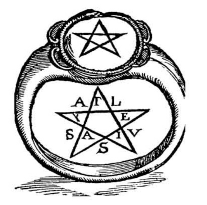 |
| The Pythagorean Signet Ring |
The Pythagorean signet ring bears the figure of the pentagram inside an Ouroboros, or serpent. It is also known as the "Salus Ring". In each of the interior angles are the Greek letters for Hygeia or the Latin letters for Salus.
Among the Pythagoreans, Hygeia’s name (HGIEiA)/(Hugieia)/(YGEIA) was interpreted as an anagram for the elements: Fire (Sun's Warmth - Heat), Water, Air, Earth, Spirit (Idea/Form, or a divine/holy, Hieron). The Pythagoreans reportedly also used the word “Hugiaine!” meaning Be sound/whole/blessed! either as a greeting or as a watchword.
14th Century ce: Pentangle
The word pentangle means “the Endless Knot.” It is found in the 14th century Middle English poem, Sir Gawain and the Green Knight. A symbol of truth, the star has five points that link and lock with each other. Each line of the pentangle passes over one line and under one line, and joins the other two lines at its ends.
The pentangle symbolizes the virtues aspired by Sir Gawain, a knight in service to the legendary King Arthur. Sir Gawain aspired to be faultless in his five senses; never to fail in his five fingers; to be strengthened by the five joys that the Virgin Mary had in Jesus (the Annunciation, Nativity, Resurrection, Ascension, and Assumption); to be faithful to the five wounds that Christ received on the cross; and to possess the five virtues: fellowship (brotherly love/friendship), courtesy, generosity, piety, and chastity.
The five-pointed star serves as a symbol of truth. The pentangle has five points that link and lock with each other, forming what is called the Endless Knot. As it can be drawn in one continuous movement of the pen, it has no beginning and no end. See Quote from Sir Gawain the the Green Knight. The anonymous author claimed the pentangle was the magical seal of the biblical King Solomon, known for his wisdom in all things, including magic.
15th Century: Pentagram
During the 15th century, Heinrich Cornelius Agrippa perpetuated the use of the pentagram as a magic symbol, attributing the “five neoplatonic elements“ to the five points.
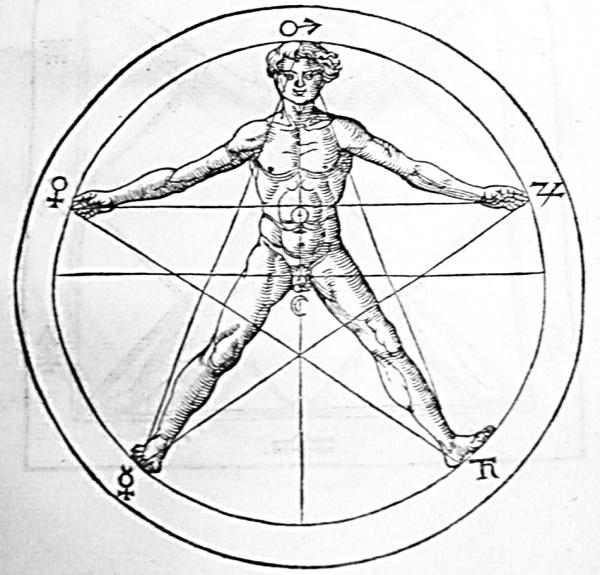
|
|
The human body inscribed in a pentagram, from Heinrich Cornelius Agrippa's Three Books of Occult Philosophy. The symbols on the perimeter of the circle represent the five planets (Mercury, Venus, Mars, Jupiter, Saturn)which are visible to the naked eye. Thus, the five points of the pentagram represent a symbol of the microcosm, as expressed in the human form. |
17th Century: Pentalpha
The word “pentalpha” is a 17th-century revival of a post-classical Greek name for this shape. It was also known as the Pentalpha of Pythagorus. This word is from pente (five) + alpha (the letter A), meaning “five alphas.” A five point star resembling five capital letter A's, joined at their bases. It also could be said to resemble five capital A’s superimposed at different rotations to make a five point star.
A
21st Century: Pentacle
Some occultists maintain that anytime a five point star is inside a circle, it properly ought to be called a pentacle.
Yet, the use of the word “pentacle” as having a specific meaning of the five point star surrounded by a circle--and used as a marking for a cemetery stone is directly connected to the Veteran Pentacle Quest in the 2000’s.
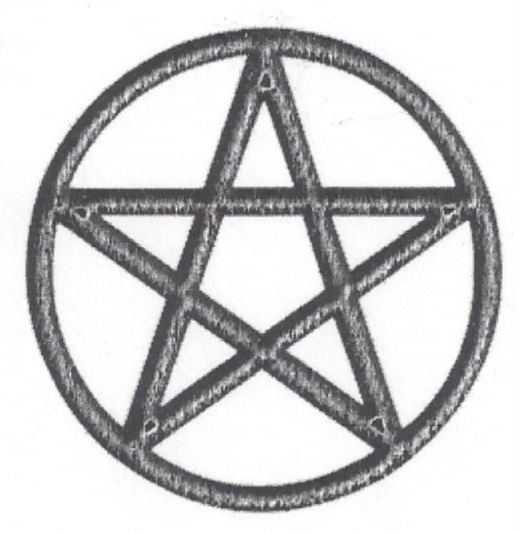 |
|
When a pentagram is surrounded by a circle, some Wiccans state that it is more correctly called a pentacle. |
0n April 23, 2007, the pentacle, as a symbol of the Wiccan religion, was finally added to the US Department of Veterans Affairs list of emblems of belief which can be included on government-issued markers, headstones, and plaques honoring deceased veterans. This Quest took nearly a decade plus the combined efforts of many individuals and organizations, including Circle Sanctuary’s Lady Liberty League and the Americans United for Separation of Church and State.
Nevertheless, I must also explain that in Ceremonial Magic the word “pentacle” is more generally used to describe any talisman or magical object which is usually disk-shaped and inscribed with symbols, figures, shapes, etc.--which or may not include a pentagram. Indeed, the Greater Key of Solomon (Clavicula Salomonis) has over forty different types of pentacles each with different symbols and functions. In Thelema, a pentacle is a talisman that is used in magical evocation, and could be made of paper, parchment, cloth, metal, or other materials upon which magical designs have been marked.
In the 20th and 21st centuries, this figure, whether called "pentagram," "pentangle," "pentalpha," or "pentacle," is also used as a symbol of protection.
Many Wiccans do use the five pointed star--by whatever name it is known--as a religious symbol.
Other Associations
During the Satanic Panic of the 1980's and 1990's, certain materials from fundamentalist Christians kept insisting this five pointed star commonly known as the pentagram was an evil Satanic symbol, and was part of a worldwide conspiracy against Christianity. Better educated people--particularly Wiccans--were not pleased.
Although this ancient symbol predates Christianity, it did acquire Christian associations. Indeed, the 14th Century reference in Sir Gawain and the Green Knight to the Pentangle has several Christian allusions. It can be found ornamenting old Christian churches. In Christian symbology, the pentagram was once used to represent the five Joys of the Madonna (the Annunciation, Nativity, Resurrection, Ascension, and Assumption), as well as to represent the five wounds of Christ. Likewise--because it could be drawn in one continuous movement of the pen—the pentagram has been associated with the Alpha and the Omega, the Beginning and the End.
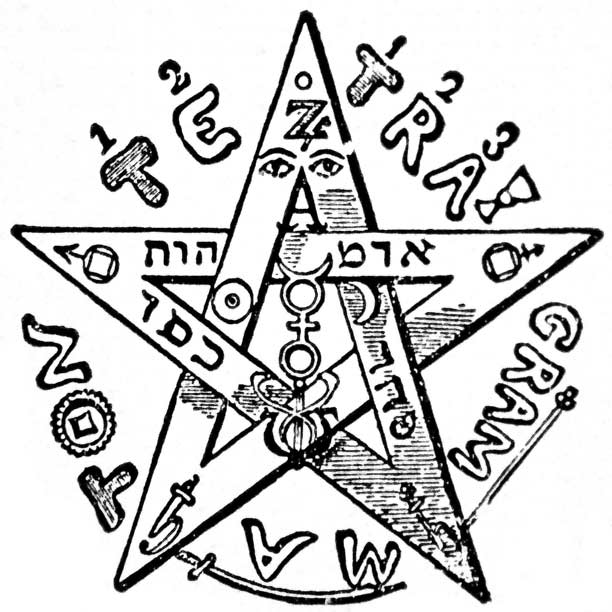 |
|
Eliphas Levi’s “Tetragrammaton pentagram”: In the 19th century, Eliphas Levi Zahed (February 8, 1810 –May 31,1875), born as Alphonse Louis Constant, was a Roman Catholic Frenchman who originally sought to enter the priesthood. He instead fell in love and married. Levi later became a ceremonial magician. The word “Tetragrammaton” is Greek, and is used as a Judeo-Christian rendering of the secret name of God. This word literally means the "Four Letters" and refers to the four Hebrew letters of the Ineffable Name--which are usually transliterated in the English alphabet as JHVH, YHWH, or IHVH. Levi’s definition of magic is more like the definition of mystical union with God. Levi seems to have been the first to declare that the pentagram--five-pointed star--with one point up and two points down represented good, while a pentagram with two points up and one point down represented evil. |
Another association of the pentagram can be found in the fraternities of Freemasonry and the Order of the Eastern Star. The Freemasons connected the pentagram with Pythagoras, the biblical Solomon, and the practice of stone masonry, traditionally traced to the building of the Temple in Jerusalem.
Sources:
Apollonios Sophistes, The Pythagorean Pentacle, 1996, revised 1999, accessed June 21, 2019.
Veteran Pentacle Quest accessed June 21, 2019
Pentacle Quest 10th Anniversary Celebration 10th Anniversary Celebration of Veteran Pentacle Quest Victory, accessed June 21, 2019
The Pentagram in Depth - Symbol Dictionary accessed June 21, 2019
Dr. Bruce G. Charlton, The pentangle - a spiritual symbol , Monday, July 7, 2014, accessed June 21, 2019.
Anonymous ["Gawain Poet" or "Pearl Poet"], Sir Gawain and the Green Knight, Pearl, Sir Orfeo, Translated by J. R. R.Tolkien, edited Christopher Tolkien, 1980. (I purchased this book when it was originally published in 1980. I was enchanted with the term, pentangle, "the Endless Knot.")
SparkNotes LLC Sir Gawain and the Green Knight Main Ideas, 2019, accessed June 21, 2019
Quote for pentangle from 14th century:
Then they showed him the shield that was of shining gules,
with the pentangle painted there in pure gold hues.
He brandishes it by the baldric, casts it about his neck,
that suited the wearer seemly and fair.
And why the pentangle applies to that prince noble,
I intend to tell, though I tarry more than I should.
It is a sign Solomon settled on some while back,
in token of truth, by the title that it has,
for it is a figure that has five points,
and each line overlaps and locks with another,
and everywhere it is endless, and English call it
over all the land, as I here, the Endless Knot.
For so it accords with this knight and his bright arms,
forever faithful in five ways, and five times so,
Gawain was for good known, and, as purified gold,
void of every villainy, with virtues adorned
all, so.
And thus the pentangle new
he bore on shield and coat,
as title of trust most true
and gentlest knight of note.–The "Gawain Poet", Sir Gawain and Green Knight 14th century. (I have bold faced some of the words to visually emphasis them.)
Dr. Charlton also provides this same verse in 14th century Middle English, which is a different Middle English dialect used in the English Midlands, rather than the one used by of Geoffrey Chaucer of The Canterbury Tales fame. This anonymous 14th century author has also been referred to as the "Pearl Poet".
Below is a copy of a flyer for a Pagan religious rights rally involving the "Quest for the Pentacle." Several different members of the Chesapeake Pagan Community, as well as other local Pagans, were involved in organizing and managing this event. Selena Fox spoke at the rally in Washington, DC.
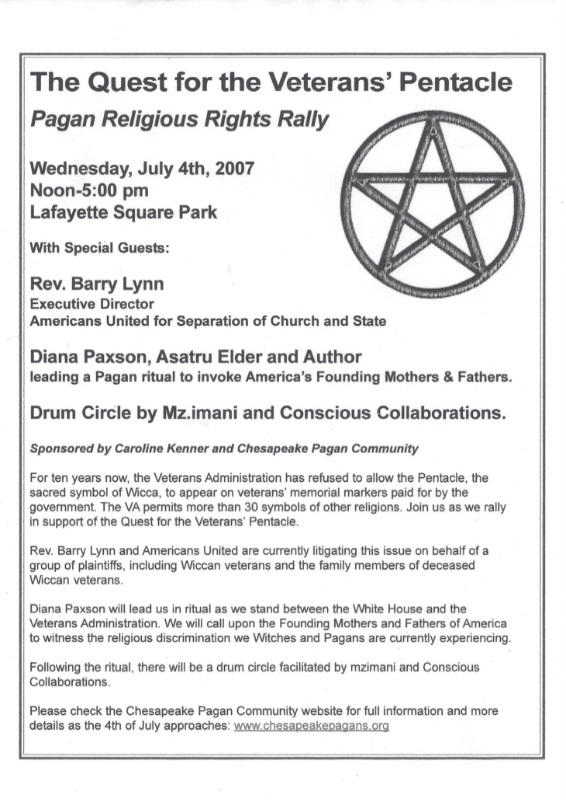
FAQ: What is the fifth element?
FAQs
"Yet Another Wicca..." home page